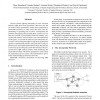Free Online Productivity Tools
i2Speak
i2Symbol
i2OCR
iTex2Img
iWeb2Print
iWeb2Shot
i2Type
iPdf2Split
iPdf2Merge
i2Bopomofo
i2Arabic
i2Style
i2Image
i2PDF
iLatex2Rtf
Sci2ools
WETICE
2002
IEEE
2002
IEEE
Analysis of an Anonymity Network for Web Browsing
Various systems offering anonymity for near real-time Internet traffic have been operational. However, they did not deliver many quantitative results about performance, bandwidth overhead, or other issues that arise when implementing or operating such a system. Consequently, the problem of designing and operating these systems in a way that they provide a good balance between usability, protection from attacks, and overhead is not well understood. In this paper, we present the analysis of an anonymity network for web browsing that offers a high level of anonymity against a sophisticated attacker and good end-to-end performance at a reasonable bandwidth overhead. We describe a novel way of operating the system that maximizes the protection from traffic analysis attacks while minimizing the bandwidth overhead. We deliver quantitative results about the performance of our system, which should help to give a better understanding of anonymity networks.
| Added | 16 Jul 2010 |
| Updated | 16 Jul 2010 |
| Type | Conference |
| Year | 2002 |
| Where | WETICE |
| Authors | Marc Rennhard, Sandro Rafaeli, Laurent Mathy, Bernhard Plattner, David Hutchison |
Comments (0)

